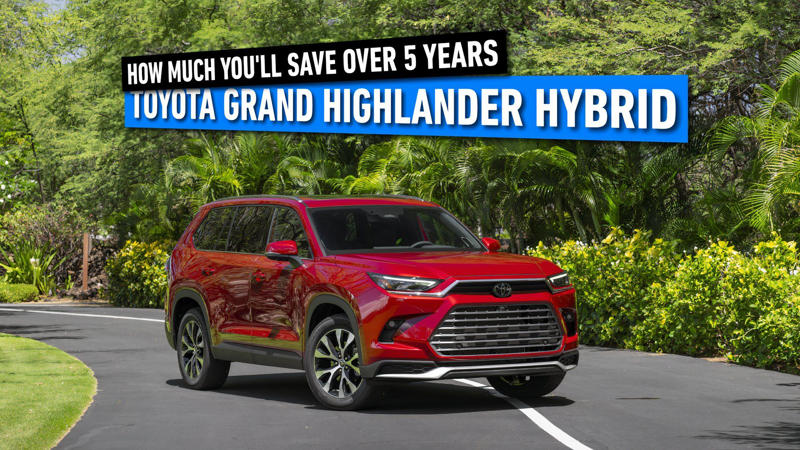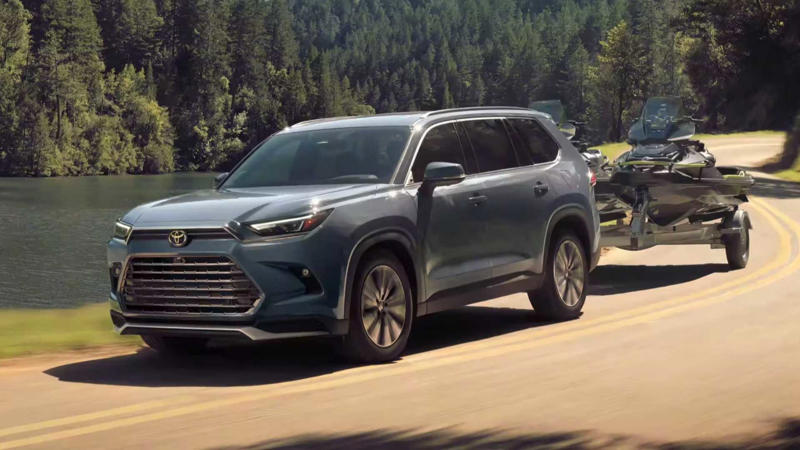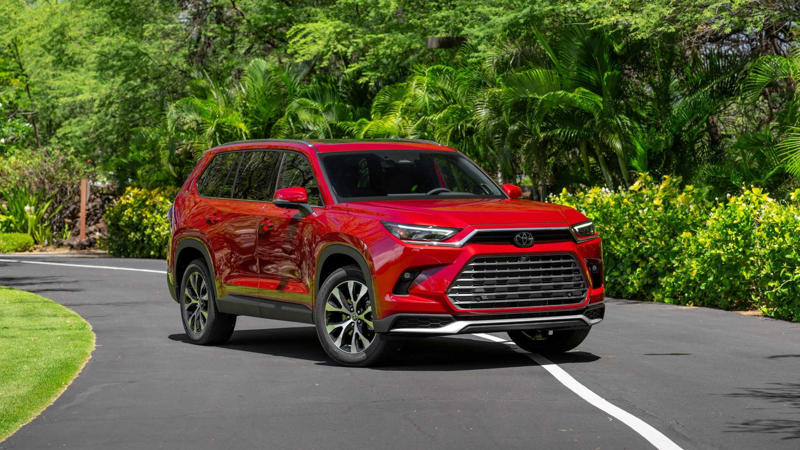The Three-Row Japanese Hybrid SUV With The Highest Fuel Cost Savings
A three-row SUV is often the best, and sometimes the only, choice for growing families—especially for those who seem to be constantly on the go. Whether they’re hauling kids to school and activities, packing up for a weekend away, or simply tackling a week’s worth of errands in one drive, a spacious SUV with flexible seating and cargo room fits the bill.
But, with size comes cost, mostly at the fuel pump, which is where hybrid technology comes in. A technology brought to mainstream auto segments by Japanese heavyweights Honda and Toyota, at around the turn of the century.
Early hybrids were compact models, maximizing economy and mostly glossing over utility. But as technology improved, automakers created larger hybrid offerings, expanding into mid-size sedans and increasingly larger SUVs, to allow those gas-guzzlers to travel farther on a tank of gasoline.
And, although the hybrid SUV market has grown over the past two decades, most of that advancement has come in compact crossovers, with only a handful of three-row hybrid SUVs—four of them are Japanese, all from the same company, with one standing out for its combination of space and fuel-cost savings.
In order to give you the most up-to-date and accurate information possible, the data used to compile this article was sourced from various manufacturer websites and other authoritative sources, including the EPA.

Toyota-Grand-Highlander-Hybrid Fuel Savings
How Much Gas Money You'll Save Over 5 Years With The Toyota Grand Highlander Hybrid
The Toyota Grand Highlander stands out from the crowd as a three-row midsize SUV loaded with amenities, but the hybrid version is even better.
The 2025 Toyota Grand Highlander Hybrid Is The Three-Row Japanese SUV With The Best Fuel Cost Savings
The EPA Estimates Drivers Will Save $1,750 Over 5 Years

2024 Toyota Grand Highlander Hybrid in red driving along road
The 2025 Toyota Grand Highlander Hybrid is a spacious three-row SUV designed for families who need room without sacrificing efficiency. Offering more passenger and cargo space than the standard Highlander, the Grand Highlander Hybrid blends Toyota’s proven hybrid technology with practicality and long-range efficiency.
According to EPA formulas, the Toyota Grand Highlander Hybrid uses about $1,300 per year on gasoline, saving owners $350 annually compared to the $1,650 yearly fuel cost of the average new ICE vehicle. These savings add up over time, making the Grand Highlander Hybrid a more cost-effective choice for long-term ownership than its comparable non-hybrid model.
How the 2025 Toyota Grand Highlander Is Ideal for Families
For some families, a spacious SUV isn’t just about comfort—it’s a necessity. For these families, daily life involves juggling school drop-offs, grocery runs, and weekend activities, all requiring a blend of passenger space and cargo capacity. A three-row SUV like the Toyota Grand Highlander ensures that kids, car seats, sports gear, and shopping bags all fit.
Larger SUVs come with higher fuel costs, but hybrid technology has changed the equation. By combining a fuel-efficient gas engine with electric power, hybrid SUVs deliver better mileage without sacrificing size or capability, making them more practical for families to get the best of both worlds—roomy, versatile transportation and lower running costs.
The Growth Of The Toyota Grand Highlander

Toyota
Japanese automakers have long been known for producing smaller, more fuel-efficient vehicles, with no better examples than the Honda CR-V and Toyota RAV4 compact SUVs of the mid-1990s, and the Honda Insight and Toyota Prius hybrids of 2000. As global demand for larger SUVs grew, Japanese brands—particularly Toyota—expanded their offerings accordingly.
Toyota has experimented with third-row seating in several of its models, including the third-generation RAV4 (2005-2011) and the Lexus RX, before settling on the Toyota Highlander (2004) and expanding on it 20 years later to create the longer and roomier Grand Highlander. Toyota also offers three rows of seats in the Sequoia and the Lexus TX (more on those later).
The 2025 Toyota Grand Highlander Hybrid Is One Step Up On The Highlander Hybrid

red 2025 Toyota Grand Highlander
The Toyota Grand Highlander was developed for 2023 as the solution to a growing demand for three-row SUVs that offered more space than the smaller Highlander, without going to a full-size truck, like the Toyota Sequoia. While the standard Highlander had been a popular choice since the turn of the century, its third row was often criticized for its lack of practical passenger room for all but the smallest occupants.
Designed to compete with larger three-row SUVs like the Dodge Durango and Volkswagen Atlas, the Grand Highlander maintains a more manageable footprint while offering improved third-row comfort and expanded cargo space over its Highlander sibling. By stretching the Highlander Hybrid’s platform, Toyota created a fuel-efficient three-row SUV.
Toyota Grand Highlander Hybrid vs. Highlander Hybrid Specs
Grand Highlander Hybrid | Highlander Hybrid | |
Powertrain | 2.5-liter I-4 or 2.4-liter turbo I-4 + 2 motors | 2.5-liter inline-4 + 3 motors |
Transmission | Continuously variable or 6-speed automatic | Continuously variable |
Power | 245–362 hp | 243 hp |
Torque | 175–400 lb-ft | 175 lb-ft |
Driveline | Front or all-wheel drive | All-wheel drive |
Range | 464–619 miles | 598–616 miles |
Efficiency City | 26–37 mpg | 35–36 mpg |
Efficiency Highway | 27–34 mpg | 34–35 mpg |
Efficiency Combined | 27–36 mpg | 35–36 mpg |
Estimated Annual Fuel Costs | $1,300–$1,750 | $1,300–$1,350 |
Fuel Cost Savings Over 5 Years | $1,500–$1,750 (2.4T costs $500 over average) | $1,500–$1,750 |
Seating | Seven | Seven or eight |
Passenger Volume | 149–153.3 cubic feet | 136.3–139.5 cubic feet |
Cargo Volume Behind Front Seats | 97.5 cubic feet | 84.3 cubic feet |
Cargo Volume Behind Middle Seats | 57.9 cubic feet | 48.4 cubic feet |
Cargo Volume Behind Rear Seats | 20.6 cubic feet | 16 cubic feet |
MSRP Range | $45,380–$58,775 | $46,020–$53,675 |
The Toyota Grand Highlander Hybrid offers significantly more passenger and cargo space than the standard Highlander Hybrid, despite sharing the same 2.5-liter hybrid powertrain (with the Grand Highlander also gaining access to the i-FORCE MAX system). The Grand Highlander is 6.5 inches longer, with a 4-inch increase in wheelbase, mostly translating into more space behind the middle seats.
Toyota Grand Highlander Hybrid vs. Sequoia Specs
Grand Highlander Hybrid | Sequoia | |
Powertrain | 2.5-liter I-4 or 2.4-liter turbo I-4 + 2 motors | 3.5-liter turbo V-6 + 1 motor |
Transmission | Continuously variable or 6-speed automatic | 10-speed automatic |
Power | 245–362 hp | 437 hp |
Torque | 175–400 lb-ft | 583 lb-ft |
Driveline | Front or all-wheel drive | Rear- or four-wheel drive |
Range | 464–619 miles | 450–495 miles |
Efficiency City | 26–37 mpg | 19–21 mpg |
Efficiency Highway | 27–34 mpg | 22–24 mpg |
Efficiency Combined | 27–36 mpg | 20–22 mpg |
Estimated Annual Fuel Costs | $1,300–$1,750 | $2,100–$2,350 |
Fuel Cost Savings Over 5 Years | $1,500–$1,750 (2.4T costs $500 over average) | ($2,250–$3,500 more than average) |
Seating | Seven | Seven or eight |
Passenger Volume | 149–153.3 cubic feet | 157 cubic feet |
Cargo Volume Behind Front Seats | 97.5 cubic feet | 86.9 cubic feet |
Cargo Volume Behind Middle Seats | 57.9 cubic feet | 49 cubic feet |
Cargo Volume Behind Rear Seats | 20.6 cubic feet | 11.5–22.3 cubic feet |
MSRP Range | $45,380–$58,775 | $62,425–$83,915 |
The 2025 Toyota Sequoia is another of the only four Japanese three-row SUVs (all Toyotas) with a self-charging hybrid powertrain, but its size and performance come with trade-offs. Unlike the Highlander and Grand Highlander Hybrids, the Sequoia is a full-size, truck-based, body-on-frame SUV, making it less fuel-efficient, though it delivers the towing capacity some families desire.

Three-row-Toyota-Hybrid-SUV-That-Offers-The-Highest-Overall-Range
The Three-row Toyota Hybrid SUV That Offers The Highest Overall Range
2024 leaves a clear best-in-class long-range, three-row hybrid SUVs coming out of Japan - but just how good is it?
The 2025 Toyota Grand Highlander Doesn’t Need Stump-Pulling Power

black 2025 Toyota Grand Highlander
Toyota’s decision to create the Grand Highlander as an elongated version of the Highlander was driven by the growing demand for larger three-row SUVs that balance space, efficiency, and practicality, which at that time meant larger, more powerful, costlier, and less fuel-conscious SUVs like the full-size Sequoia.
And though Toyota has more powerful hybrid powertrains, like the i-FORCE MAX in the Sequoia, it decided to power the lighter-weight Grand Highlander, which likely doesn’t need the pulling power to Sequoia, using the ubiquitous 2.5-liter “four” to maximize efficiency, and not change the vehicle dynamics to much from the non-hybrid Grand Highlander.
Toyota Grand Highlander Hybrid vs. Grand Highlander Specs
Grand Highlander Hybrid | Grand Highlander | |
Powertrain | 2.5-liter I-4 or 2.4-liter turbo I-4 + 2 motors | 2.4-liter turbo inline-4 |
Transmission | Continuously variable or 6-speed automatic | 8-speed automatic |
Power | 245–362 hp | 265 hp |
Torque | 175–400 lb-ft | 310 lb-ft |
Driveline | Front or all-wheel drive | Front or all-wheel drive |
Range | 464–619 miles | 392–427 miles |
Efficiency City | 26–37 mpg | 20–21 mpg |
Efficiency Highway | 27–34 mpg | 26–28 mpg |
Efficiency Combined | 27–36 mpg | 22–24 mpg |
Estimated Annual Fuel Costs | $1,300–$1,750 | $1,950–$2,100 |
Fuel Cost Savings Over 5 Years | $1,500–$1,750 (2.4T costs $500 over average) | ($1,500–$2,250 more than average) |
MSRP Range | $45,380–$58,775 | $39,520–$51,925 |
The 2025 Toyota Grand Highlander Hybrid features a 2.5-liter four-cylinder Atkinson-cycle powertrain, prioritizing fuel efficiency over raw power. While it delivers adequate performance for family driving, its main advantage is lower fuel costs and affordability.
Compared to the ICE Grand Highlander, which uses a turbocharged 2.4-liter engine (which the top-tier Grand Highlander Hybrid hybridizes), the hybrid offers considerably better mileage and exceptional long-term savings.
Lexus TX Plug-In Hybrid Specs
550h F Sport Performance | 550h+ Luxury | |
Powertrain | 2.4-liter turbo I-4 + 2 motors | 3.5-liter turbo V-6 + 3 motors |
Transmission | Continuously variable or 6-speed automatic | 8-speed automatic |
Power | 366 hp | 404 hp |
Torque | 406 lb-ft | 317 lb-ft |
Driveline | Front or all-wheel drive | Front or all-wheel drive |
Range | 481 miles | Not yet rated |
Efficiency City | 27 mpg | Not yet rated |
Efficiency Highway | 28 mpg | Not yet rated |
Efficiency Combined | 27 mpg | Not yet rated |
Estimated Annual Fuel Costs | $2,200 | Not yet rated |
Fuel Cost Savings Over 5 Years | ($2,750 more than the average vehicle) | Not yet rated |
MSRP Range | $70,010–$73,160 | $78,560 |
The 2025 Lexus TX offers both hybrid and plug-in hybrid (PHEV) powertrains, giving buyers a choice of efficiency or performance. While the PHEV provides all-electric driving that Lexus estimates at 33 miles, it doesn’t offset the added cost to purchase the PHEV (plus, research shows many owners rarely plug their PHEVs in).
The 2025 Toyota Grand Highlander Hybrid Beats Out Family Members As The Best Fuel-Saving Three-Row Japanese Hybrid SUV

Toyota
The Toyota Grand Highlander Hybrid stands out as the top choice among three-row, self-charging hybrid SUVs from a Japanese automaker. It delivers the same five-year fuel cost savings as the smaller Highlander Hybrid while offering substantially more interior space and versatility, making it an ideal option for families who want space and savings.
Of note, there are only four models in the entire three-row, self-charging Japanese hybrid SUV segment, and they’re all Toyota-built—the Highlander Hybrid, Grand Highlander Hybrid, Sequoia Hybrid, and Lexus TX 500h. Other Japanese brands have embraced PHEVs, like Mitsubishi and Mazda, or focused on smaller self-charging hybrids, such as Honda and Subaru.
Self-charging hybrid SUVs will continue to serve as cost-effective alternatives to fully electric models in the near future, especially for buyers prioritizing fuel efficiency without charging routines, and to meet the interior-space requirements of families, there is none better from Japan than the Toyota Grand Highlander Hybrid.













































